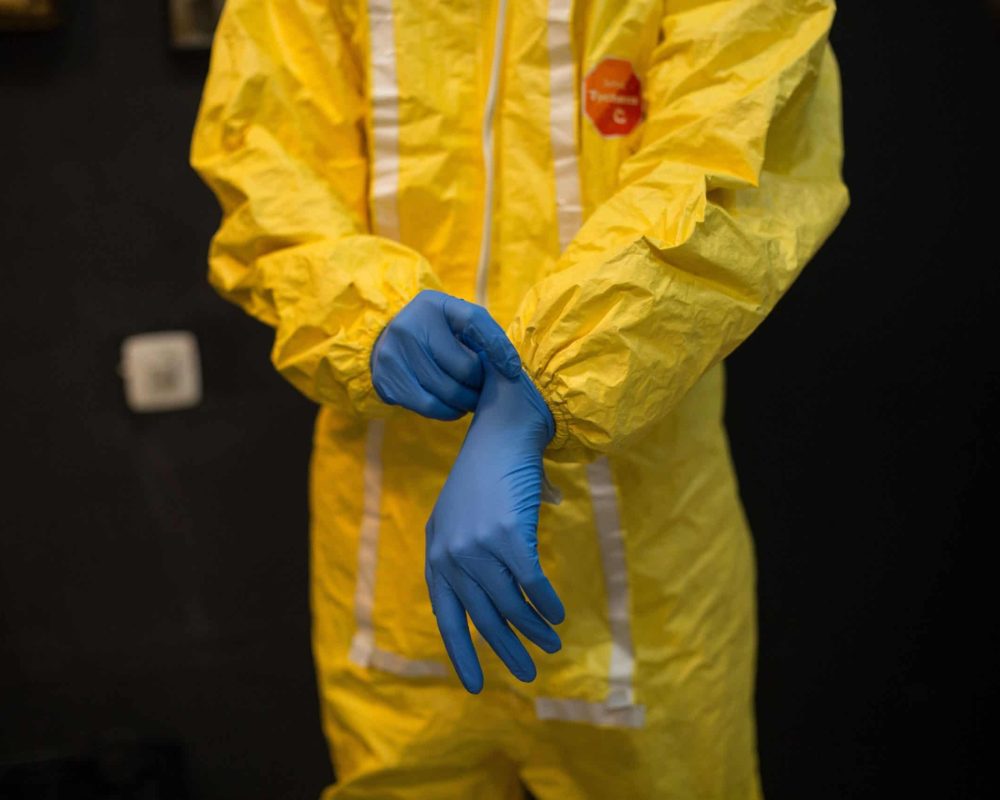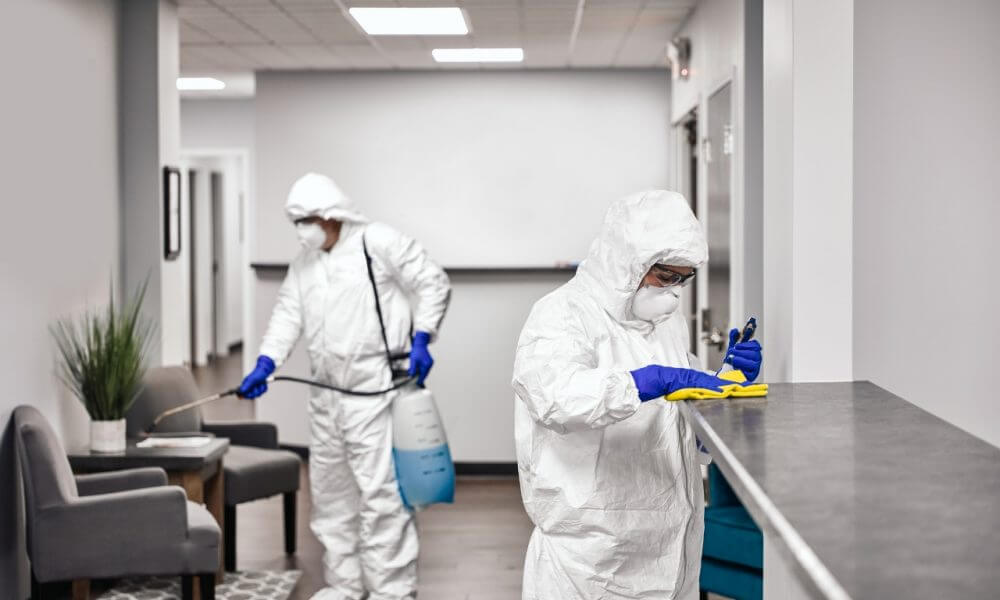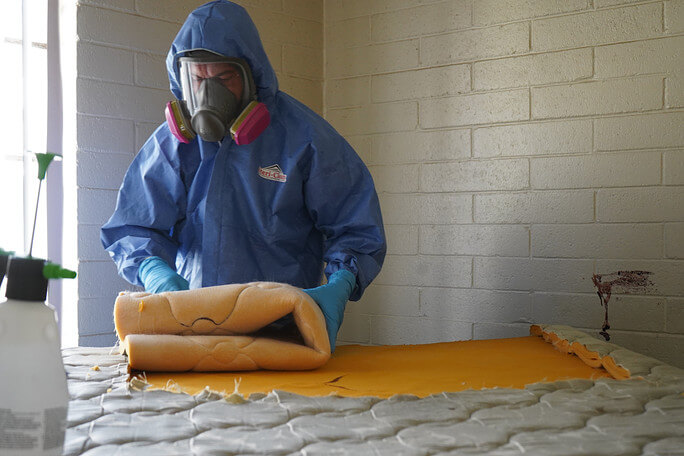Flood Damage Restoration: Quick and Efficient Healing for Your Home
Wiki Article
Specialist Biohazard Cleanup for Criminal Activity Scenes, Injury Incidents, and Contaminated Areas
In the realm of expert biohazard cleaning, precise attention to detail and adherence to safety and security procedures are paramount. When confronted with the results of a crime scene, trauma event, or any infected area, the relevance of appropriate cleanup can not be understated. The dangers and complexities connected with biohazards call for customized knowledge and proficiency to make sure efficient removal. As we explore the details of biohazard clean-up for these delicate settings, a much deeper understanding of the obstacles and crucial procedures included will emerge, clarifying the crucial duty of professional cleaning services in bring back safety and security and tranquility of mind.
Relevance of Biohazard Clean-up
Biohazard clean-up complying with criminal offense scenes and injury incidents is vital for guaranteeing the safety of people and the atmosphere. When these events take place, they typically leave a selection of biohazards such as blood, physical liquids, and other potentially transmittable materials. These compounds can harbor dangerous microorganisms like infections and bacteria, presenting significant health dangers otherwise properly cleaned up and sterilized.Professional biohazard clean-up solutions are educated to take care of these unsafe materials safely and properly. They have the required devices, such as personal protective gear and specialized cleaning agents, to completely sanitize the impacted areas. By entrusting the cleanup to trained experts, individuals can prevent exposure to hazardous pathogens and avoid the spread of infectious diseases.
Moreover, correct biohazard cleanup is vital for shielding the atmosphere. Incorrect disposal of biohazardous materials can contaminate soil, water resources, and air, posturing a hazard to wild animals and the ecological community. By adhering to stringent clean-up protocols, specialists can make certain that biohazards are securely eliminated and thrown away based on policies, lessening the risk of ecological contamination.
Kinds Of Biohazards Encountered
Various hazardous products frequently experienced in crime scenes and injury occurrences present significant health and wellness risks otherwise taken care of appropriately. Blood and physical fluids are amongst the most common biohazards located in these circumstances. These liquids can bring virus such as HIV, liver disease B and C, and other hazardous microbes. Additionally, tissues, body organs, and body components can also posture significant wellness risks due to potential contamination.Another type of biohazard frequently encountered is sharp things like needles, damaged glass, and various other products that can cause injuries and transfer infections. Chemical threats are also a concern, as criminal offense scenes might consist of substances like tear gas, pepper spray, or medication manufacturing materials that require specialized handling and disposal treatments to avoid additional damage.
Furthermore, mold and mildew and microorganisms growth can occur in areas where decomposition or prolonged direct exposure to wetness has happened. These microbes can release contaminants and allergens right into the air, positioning breathing dangers to those subjected. Generally, biohazard cleaning specialists have to be skilled and fully equipped to successfully handle these different kinds of hazardous materials to guarantee the safety of themselves and others.
Equipment and Safety Equipment
When resolving the essential task of handling biohazards experienced in criminal activity scenes and injury incidents, the use of correct tools and protective gear is vital to making sure the safety of people included in the clean-up procedure. Personal protective devices (PPE) such as gloves, coveralls, masks, and goggles are vital to stop direct call with potentially unsafe materials. Respirators are important when taking care of biohazards that might become air-borne, shielding workers from inhaling unsafe particles. Specialized cleansing tools like biohazard bags, disinfectants, and sharps containers are necessary for the safe collection and disposal of contaminated products. In addition, sturdy equipment such as industrial-grade cleaner, foggers, and ozone generators might be needed to extensively sanitize the afflicted location. Making sure that all devices is effectively kept, frequently examined, and made use of according to safety guidelines is vital in lessening the danger of direct exposure to biohazards throughout clean-up procedures.
Clean-up Process and Methods
Reliable and complete cleanup of biohazardous products from crime scenes and trauma cases requires meticulous attention click here now to detail and adherence to strict security methods. The cleaning procedure normally entails a number of essential steps. Initially, the area needs to be assessed to establish the extent of contamination and the suitable cleansing methods needed. Next off, all biohazardous products, including blood, bodily liquids, and tissue deposits, should be thoroughly eliminated and thrown away in conformity with regional guidelines.Following the elimination of biohazardous products, the damaged area goes through a thorough cleaning and disinfection process. This action involves using specialized cleaning agents and tools to make sure that all traces of contamination are eradicated. After cleansing, the area goes through extensive screening to validate that it is cost-free and safe of any type of remaining biohazards.

Purification and Disposal Procedures
To ensure extensive decontamination and proper disposal of biohazardous materials, complying with the precise cleanup process, details treatments should be thoroughly adhered to with rigorous adherence to safety and security protocols. Purification entails the elimination or neutralization of pollutants to reduce the danger of direct exposure and spread of hazardous substances. This procedure commonly consists of cleansing, sanitizing, and sanitizing the damaged area using specialized equipment and EPA-approved chemicals.Once purification is finished, appropriate disposal of biohazardous products is essential to avoid more contamination or harm. Biohazardous waste, such as bodily liquids or blood-soaked products, need to be very carefully accumulated, packaged, and labeled according to regulative standards. ATP testing. These products are after that carried to qualified facilities for disposal through proper networks, making sure conformity with local, state, and federal guidelines

Conclusion
To conclude, expert biohazard clean-up is critical for making sure the effective and secure removal of dangerous products from criminal activity scenes, trauma incidents, and infected rooms. By using specialized tools, protective gear, and adhering to appropriate clean-up procedures and methods, biohazard cleanup groups can efficiently sanitize and dispose of biohazards, reducing the threat of exposure and injury to individuals and the setting.Web Site As we dig into the ins and outs of biohazard cleanup for these delicate environments, a much our website deeper understanding of the challenges and critical procedures included will emerge, losing light on the vital role of specialist cleanup services in restoring safety and security and peace of mind.
Specialist biohazard cleanup services are educated to handle these harmful materials safely and properly. By following stringent cleaning protocols, specialists can ensure that biohazards are securely gotten rid of and disposed of in accordance with guidelines, decreasing the risk of environmental contamination.
Generally, biohazard clean-up specialists should be well-appointed and qualified to successfully take care of these numerous types of dangerous materials to make sure the safety and security of themselves and others.
When addressing the critical task of taking care of biohazards encountered in criminal offense scenes and trauma occurrences, the use of appropriate tools and safety equipment is extremely important to ensuring the safety of individuals entailed in the cleanup process.
Report this wiki page